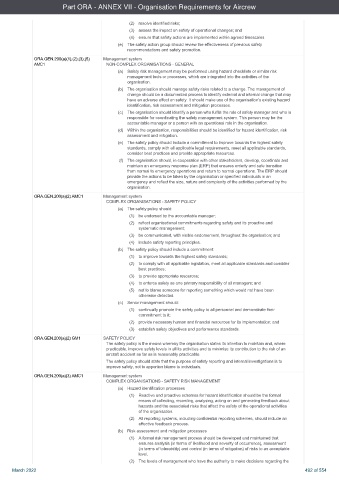Page 492 - UK AirCrew Regulations (Consolidated) March 2022
P. 492
Part ORA - ANNEX VII - Organisation Requirements for Aircrew
(2) resolve identified risks;
(3) assess the impact on safety of operational changes; and
(4) ensure that safety actions are implemented within agreed timescales.
(e) The safety action group should review the effectiveness of previous safety
recommendations and safety promotion.
ORA.GEN.200(a)(1);(2);(3);(5) Management system
AMC1 NON-COMPLEX ORGANISATIONS - GENERAL
(a) Safety risk management may be performed using hazard checklists or similar risk
management tools or processes, which are integrated into the activities of the
organisation.
(b) The organisation should manage safety risks related to a change. The management of
change should be a documented process to identify external and internal change that may
have an adverse effect on safety. It should make use of the organisation’s existing hazard
identification, risk assessment and mitigation processes.
(c) The organisation should identify a person who fulfils the role of safety manager and who is
responsible for coordinating the safety management system. This person may be the
accountable manager or a person with an operational role in the organisation.
(d) Within the organisation, responsibilities should be identified for hazard identification, risk
assessment and mitigation.
(e) The safety policy should include a commitment to improve towards the highest safety
standards, comply with all applicable legal requirements, meet all applicable standards,
consider best practices and provide appropriate resources.
(f) The organisation should, in cooperation with other stakeholders, develop, coordinate and
maintain an emergency response plan (ERP) that ensures orderly and safe transition
from normal to emergency operations and return to normal operations. The ERP should
provide the actions to be taken by the organisation or specified individuals in an
emergency and reflect the size, nature and complexity of the activities performed by the
organisation.
ORA.GEN.200(a)(2) AMC1 Management system
COMPLEX ORGANISATIONS - SAFETY POLICY
(a) The safety policy should:
(1) be endorsed by the accountable manager;
(2) reflect organisational commitments regarding safety and its proactive and
systematic management;
(3) be communicated, with visible endorsement, throughout the organisation; and
(4) include safety reporting principles.
(b) The safety policy should include a commitment:
(1) to improve towards the highest safety standards;
(2) to comply with all applicable legislation, meet all applicable standards and consider
best practices;
(3) to provide appropriate resources;
(4) to enforce safety as one primary responsibility of all managers; and
(5) not to blame someone for reporting something which would not have been
otherwise detected.
(c) Senior management should:
(1) continually promote the safety policy to all personnel and demonstrate their
commitment to it;
(2) provide necessary human and financial resources for its implementation; and
(3) establish safety objectives and performance standards.
ORA.GEN.200(a)(2) GM1 SAFETY POLICY
The safety policy is the means whereby the organisation states its intention to maintain and, where
practicable, improve safety levels in all its activities and to minimise its contribution to the risk of an
aircraft accident as far as is reasonably practicable.
The safety policy should state that the purpose of safety reporting and internal investigations is to
improve safety, not to apportion blame to individuals.
ORA.GEN.200(a)(3) AMC1 Management system
COMPLEX ORGANISATIONS - SAFETY RISK MANAGEMENT
(a) Hazard identification processes
(1) Reactive and proactive schemes for hazard identification should be the formal
means of collecting, recording, analysing, acting on and generating feedback about
hazards and the associated risks that affect the safety of the operational activities
of the organisation.
(2) All reporting systems, including confidential reporting schemes, should include an
effective feedback process.
(b) Risk assessment and mitigation processes
(1) A formal risk management process should be developed and maintained that
ensures analysis (in terms of likelihood and severity of occurrence), assessment
(in terms of tolerability) and control (in terms of mitigation) of risks to an acceptable
level.
(2) The levels of management who have the authority to make decisions regarding the
March 2022 492 of 554

